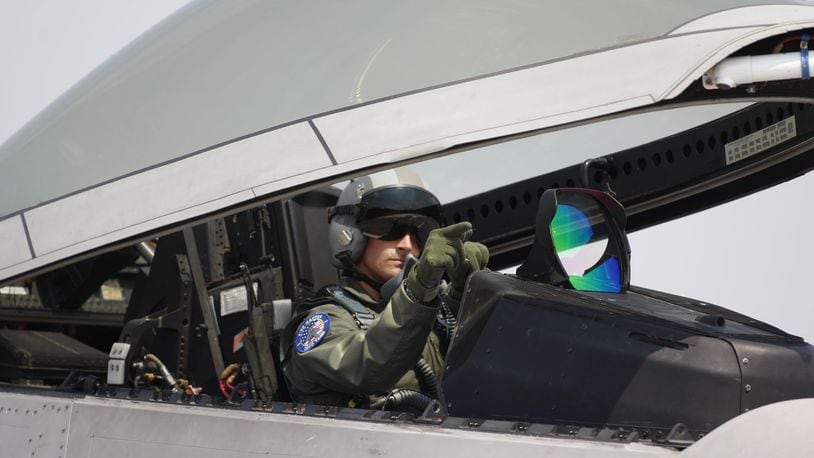Now, the Air Force is about 2,000 pilots short – out of a total force of about 23,000 — and most of the shortage is in the fighter pilot ranks, leaders have said.
RELATED: Air Force facing growing crisis in pilot shortage
The loss in military ranks takes a high toll in both experience and dollars. The Air Force estimates it costs between $3 million to $11 million over five years to train a pilot, depending on the aircraft type.
John “Jazz” Jannazo, a former Air Force fighter pilot and now a defense industry consultant in Fairborn, said the GAO report that interviewed squadron leaders and members, was “spot on.”
It takes five years to be a fully qualified fighter pilot, he said.
“It takes time, and investment in our training bases – basic training, advance training, basic fighter training, advanced fighter training – all before you hit your operational squadron, and start to address the shortage,” he said in an email.
Fewer pilots in the cockpit is a trend in the other services that fly fixed-wing jets. The GAO report found the Air Force, Navy and Marine Corps had gaps between the number of fighter pilots and what was authorized in fiscal years 2013 through 2017.
Marine fighter pilot vacancies grew to 24 percent last year compared to 6 percent below authorizations in 2013, GAO said.
RELATED: House defense leader at Wright-Patt says Air Force pilot shortage growing
For a pilot’s first flying tour, the Navy reported the gap grew to 26 percent last year compared to 12 percent in 2013. The shortfall could continue at least another year, GAO said.
Despite the challenges, the military services told GAO they were able to fully staff deploying squadrons, but that has meant in extending some deployments or pulling pilots out of non-deploying squadrons.
Getting back to full manning levels will take “the political will” of Congress and the president “to fund the training venues and the pipelines needed to ramp up to a level where we can close the gap, and then maintain the funding levels to ensure the gap does not come back the next time we get a ‘peace dividend,’” Jannazo said.
The report cited increased workloads for pilots in squadrons, fewer aircraft to fly, less training hours and more time in maintenance for aging aircraft among causes leading aviators to leave. The Air Force also drew more than 200 aviators between fiscal years 2011 and 2012 from fighter pilot ranks to fly unmanned drones, the report said.
RELATED: Artificial Intelligence will transform warfare, AFRL scientist says
Pilots have cited high deployment tempos and an airline hiring binge as other factors.
“Anybody who has flown on an airline recently can see that the civilian air traffic system is operating at close to capacity, so there is a lot of demand for pilots,” said Loren B. Thompson, a senior defense analyst with the Lexington Institute in Arlington, Va. “The airlines have traditionally recruited many of their pilots from the military, and today’s high demand has bid up prices to attractive levels.”
The Air Force has increased bonuses to aviators who stay, rising from $125,000 in 2012, to $225,000 the following year to up to $455,000 most recently.
More money hasn’t stopped the exodus. The take-rate has declined from 63 percent in fiscal year 2013 to 35 percent in fiscal year 2017, the GAO said.
“Once again money is the short-term answer to the retention—pay bonuses,” said Kenneth E. Curell, a Centerville resident and former Air Force and Air National Guard fighter pilot. “Not surprisingly bonus taker percentages decline in times of economic upturns and airline hiring and increase when the opposite is the case.”
While the military has put incentives into place to keep experienced pilots, there are “major drawbacks to military life,” Thompson said. “Pilots may not see their families for months at a time, and they may have to risk their lives while accomplishing missions. That kind of work can look less appealing as pilots age.”
RELATED: Wright-Patt a contender to manage stealth fighter program
More broadly, Curell said in an email, there is a disconnect between the those who have served in uniform and those who haven’t.
Less than 1 percent of the population who serve traditionally reflect “a significant percentage of offspring of military members who joined the military like their parents,” he wrote. “That number is declining and coupled with the continuing disconnect between military members and our nation’s civilian leadership and population, the military is at risk of being able to fill its authorizations.
RELATED: ‘We’re not moving fast enough,’ AFRL leader says
“We have a Congress with little-to-no military experience, a President with none and congressional staffers with even less,” he added in an email. “Yet those are the very individuals determining the strategic pathway for the military and their views are not aligned with the realities of what our military is enduring.”
Already stressed, more demands have been placed on the military services facing “never-ending deployments, threats of additional military commitments,” and short-term stopgap funding that undermines stable funding for operations, training and buying equipment, he added.
About the Author
